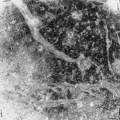Ganymede City
Ganymede City is a term coined by Arthur C. Clarke in his science fiction novel, 3001: The Final Odyssey. It refers to two regions, Lagash Sulcus and Memphis Facula, on the surface of one of Jupiter's moons, Ganymede. When viewed from space these regions have a criss-crossing pattern of what appears to be "streets and avenues". However these "streets and avenues" would be ten kilometers wide. Clarke said: "To my eyes it appears considerably more artificial than the notorious 'Mars Face' and its surroundings."[1]
In the "Sources" section of his novel, 3001: The Final Odyssey, Clarke specifically referred to these two satellite images when speaking of "Ganymede City". They were taken by the Voyager 2 probe and Clarke referred to them by their Flight Data Subsystem (FDS) numbers.[2]
-

Lagash Sulcus, FDS 20637.29
-

Memphis Facula, FDS 20637.02